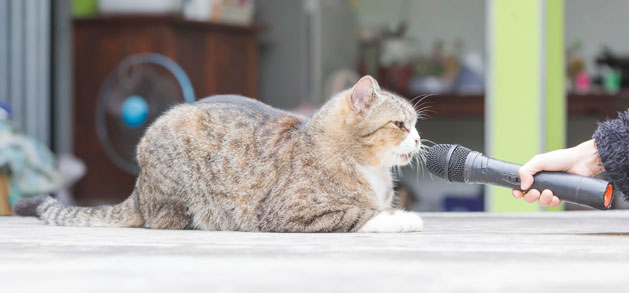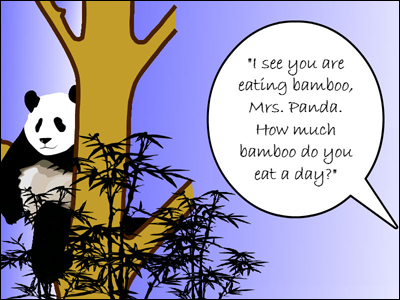

Everyday scientists are learning more and more about how animals “talk.” For example, there is now an elephant voices dictionary that helps humans understand the meaning of elephant calls and gestures subsonic.
Students will use their powers of research, observation, and questioning to create an interview with an animal; interviewing it to help others learn more about what makes it so amazing as well as the issues it faces in the wild.
Inspire your student's curiosity about animal's unique characteristics by visiting the San Diego Zoo Kids web site and exploring some of the amazing animals found there. Depending on the literature you have been reading with students, you may want to start with a specific animal. For example, if you have been reading Verdi, by Janell Cannon, to your class, start with the python.
Ask your students to share what they know about other amazing animals. Help lead students to the realization that a unique physical or behavioral adaptation is what makes the animal interesting. To get them talking, ask students to share:
Let students know that they will become animal researchers who will inspire others about the wonders of animals, their unique adaptations, and the challenges this animal faces in the wild through a mock interview with the animal!
Group students together in pairs by interest in the same animal, keeping in mind work style, ability, and personality. Working together will make the research process a bit easier and provides for an easy split into interviewer and interviewee (animal) when they record the interview. If students have a team mate to question first, you will also have a bit more time to talk to different groups and identify misconceptions.
Students should begin by completing research about the animal. Graphic organizers, like clusters, may be helpful for them to organize the information they find about the habitat, food, physical characteristics, and predators of the animal they are studying.
Create a Graphic Organizer
Need a thought web, timeline, flowchart, or other graphic organizer for a lesson?
CreateTheir research should answer questions like:
Tell your students they will be sharing their research through an interview with their animal. Their animal will describe how it looks, what it eats, and where it lives by answering questions from a reporter.

This might be a good time to talk to your students about personification. While the goal is to share information in a fun and unique way, you can focus on writing and language skills by asking students to consider:
When they have enough information about their animal, students should begin dividing up the information into questions and answers. While you can provide the questions, having students develop the questions on their own is a powerful way to have them start organizing information and thinking like scientists.
Using a tool like Wixie® have students enhance their interview with images and voice narration.
If your students are ready, give them flexibility to choose how many pages or slides in their interview as well as how it is organized. If they need more structure, you could suggest they create pages for:
Have students develop illustrations for each question and answer and record the interview. They can create original illustrations, find photographs, and even capture their image to add to the project using a digital camera or web cam.
Have students present their interviews to the rest of the class or local animal expert, such as a ranger from a local park or nature center. Post interviews to your class website, a station in the school media center where other students can use for their own research purposes.
The final interview and student work during the process will help you evaluate understanding of physical characteristics, habitats, and adaptations.
Monitor progress and encourage the use of graphic organizers as students begin their research. Work closely with students as they develop their interview questions, as their formulation of the questions will demonstrate comprehension of big ideas behind the facts they find. Their written interview may also serve as both a formative and summative assessment.
As students begin illustrating, prompt them with questions about their animals to encourage them to add more details and create accurate illustrations.
The resulting interviews serve as an artifact for a unique summative assessment of informative writing. Be sure to evaluate student recording for fluency and content accuracy.
Nicola Davies. Extreme Animals: The Toughest Creatures on Earth. ISBN: 0763641278
Pamela Hickman. Animals in Motion: How Animals Swim, Jump, Slither and Glide. ISBN: 1550745751
LS1.A: Structure and Function
Plants and animals have both internal and external structures that serve various functions in growth, survival, behavior, and reproduction. (4-LS1-1)
LS3.A: Inheritance of Traits
Many characteristics of organisms are inherited from their parents. (3-LS3-1)
Other characteristics result from individuals' interactions with the environment, which can range from diet to learning. Many characteristics involve both inheritance and environment. (3-LS3-2)
LS3.B: Variation of Traits
The environment also affects the traits that an organism develops. (3-LS3-2)
LS4.C: Adaptation
For any particular environment, some kinds of organisms survive well, some survive less well, and some cannot survive at all. (3-LS4-3)
Reading Theme
Key Ideas and Details
1. Read closely to determine what the text says explicitly and to make logical inferences from it; cite specific textual evidence when writing or speaking to support conclusions drawn from the text.
Craft and Structure
Writing Theme
Text Type and Purpose
2. Write informative/explanatory texts to examine and convey complex ideas and information clearly and accurately through the effective selection, organization, and analysis of content.
Production and Distribution of Writing
4. Produce clear and coherent writing in which the development, organization, and style are appropriate to task, purpose, and audience.
Research to Build Present Knowledge
7. Conduct short as well as more sustained research projects based on focused questions, demonstrating understanding of the subject under investigation.
Speaking and Listening Theme
Comprehension and Collaboration
2. Integrate and evaluate information presented in diverse media and formats, including visually, quantitatively, and orally.
Presentation of Knowledge and Ideas
4. Present information, findings, and supporting evidence such that listeners can follow the line of reasoning and the organization, development, and style are appropriate to task, purpose, and audience.
3. Knowledge Constructor
Students critically curate a variety of resources using digital tools to construct knowledge, produce creative artifacts and make meaningful learning experiences for themselves and others. Students:
a. plan and employ effective research strategies to locate information and other resources for their intellectual or creative pursuits.
b. evaluate the accuracy, perspective, credibility and relevance of information, media, data or other resources.
c. curate information from digital resources using a variety of tools and methods to create collections of artifacts that demonstrate meaningful connections or conclusions.
d. build knowledge by actively exploring real-world issues and problems, developing ideas and theories and pursuing answers and solutions.
6. Creative Communicator
Students communicate clearly and express themselves creatively for a variety of purposes using the platforms, tools, styles, formats and digital media appropriate to their goals. Students:
a. choose the appropriate platforms and tools for meeting the desired objectives of their creation or communication.
b. create original works or responsibly repurpose or remix digital resources into new creations.
c. communicate complex ideas clearly and effectively by creating or using a variety of digital objects such as visualizations, models or simulations.
d. publish or present content that customizes the message and medium for their intended audiences.

Follow us on Instagram for daily inspiration

Create a thought web, cluster, flowchart, or other graphic organizer for a lesson
8 first projects to get students using technology
Creative, digital book reviews
Fun and powerful ideas with animated characters

Wixie
Share your ideas, imagination, and understanding through writing, art, voice, and video.

Rubric Maker
Create custom rubrics for your classroom.

Pics4Learning
A curated, copyright-friendly image library that is safe and free for education.

Wriddle
Write, record, and illustrate a sentence.

Get creative classroom ideas delivered straight to your inbox once a month.
Topics